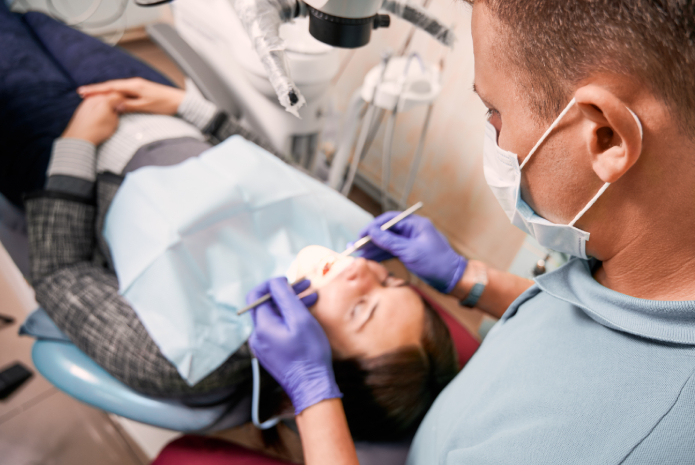On the occasion of World No Tobacco Day, which is celebrated on May 31, several organizations want to remember “the importance of periodic dental check-ups to detect any malignant lesion in time and improve the prognosis of the disease.”
As indicated by the Illustrious College of Dentists and Stomatologists of Aragon, “Tobacco is one of the main risk factors for head and neck cancer, which are located, above all, in the larynx, oral cavity, oropharynx and nasopharynx; types of cancer that account for 5% of tumors diagnosed throughout Spain. In fact, people who smoke and drink are 15 times more likely to develop oral cancer”.
Thus, according to the Spanish Society of Medical Oncologyit is estimated that “By 2024, 7,603 cases of oral and pharyngeal cancer will be diagnosed. A disease with high mortality, largely due to its late diagnosis, since 75% of these tumors are detected in advanced stages. The delay in requesting professional consultation lengthens the time until treatment is received by 40%, which is why oral cancer causes around 1,500 deaths a year.”.
In this sense, the mortality figures for this pathology could be reduced if it were detected in time, raising the survival rate to 90%. Oral and pharyngeal cancer affects, above all, to men over 45 years of ageso the College of Dentists and Stomatologists of Aragon reminds us that “It is necessary for the population to go for a dental check-up once a year or whenever an abnormality is seen in the oral cavity, since the dentist will be able to diagnose any potentially malignant lesion.”.
In fact, the Dr. Jesús Frieyropresident of Illustrious Official College of Dentists and Stomatologists of Asturias (CODES)explains that “dentists have a crucial role in the early detection and intervention of oral damage associated with smoking. Our position allows us to not only treat, but also educate patients about how to quit smoking and the significant benefits of doing so.. Quitting smoking offers immediate and long-term benefits to oral health. Patients who quit tobacco experience a rapid improvement in the health of your gums, reduction in the incidence of oral ulcers and a decrease in the risk of oral cancer. In addition, the improvement in breath and the reduction in tooth discoloration are positive aesthetic changes that reinforce self-esteem and psychological well-being.”
How does tobacco affect orthodontic treatments?
From the Spanish Society of Orthodontics and Dentofacial Orthopedics (SEdO) They also join the awareness campaign about the negative effects of tobacco and emphasize “the importance of professional and safe supervision in orthodontics, and highlights how tobacco use can seriously compromise desired results”.
Likewise, the president of the SEdO, the Dr. Juan Carlos Pérez Varela warns that “tobacco consumption not only causes visible stains and general deterioration of teeth, but also negatively affects blood circulation and the regenerative capacity of oral tissues.. These systemic effects of tobacco reduce the efficiency with which the teeth can move to their new positions and prolong the time needed to complete orthodontic treatment”.
Additionally, tobacco increases the risk of root resorption, a process in which the roots of teeth become weak or reduced during orthodontic treatment. “This complication may compromise the long-term stability of treatment results.leading to increased tooth mobility that may require additional interventions or even more invasive corrective treatments”says the president of the Society.
The delay in requesting professional consultation lengthens the time until treatment is received by 40%, which is why oral cancer causes around 1,500 deaths a year.
“When smoking, the immunological and healing response of oral tissues is compromised, which is crucial during dental readjustment. This compromise can lead to a number of serious complications, such as gum infections and healing problems post-adjustment of orthodontic appliances. These conditions are not only painful and complicate treatment, but can also significantly prolong its duration,” warns Dr. Pérez Varela.
Likewise, tobacco is closely linked to the development of periodontal diseases. In this sense, the SEdO indicates that “a patient who is receiving orthodontic treatment, the presence of periodontal disease can weaken these supporting tissuescompromising the stability of the teeth once relocated and increasing the risk of long-term tooth loss.”
“Likewise, reduced blood flow in the oral tissues due to tobacco consumption decreases the body’s ability to fight infections and heal, which can affect overall oral health and further delay orthodontic treatment progress. Therefore, smoking not only negatively affects dental aesthetics and chewing function, but also increases the risk of serious complications that can have long-lasting consequences on the patient’s oral and general health”, summarizes the president of the SEdO.
To guarantee the success of orthodontic treatment and maximize its effectiveness, the SEdO advises patients to “consider giving up the tobacco habit. Quitting smoking not only favors the effectiveness of orthodontic treatment by improving the tissue response to it, but also It also has a direct, positive impact on the overall health of your gums and oral tissue.”.
The dentist and cancer treatment
In addition to the role of the dentist in the diagnosis of oral cancer, the Illustrious College of Dentists and Stomatologists of Aragon emphasizes that this has a key role before, during and after any oncological treatmentsince it can help mitigate the side effects that chemotherapy and radiotherapy cause in the oral condition of patients:
- Oral mucositis: inflammation and ulceration of the mucous membranes in the mouth that can cause pain, difficulty swallowing and increase the risk of infections.
- Xerostomia (dry mouth): Chemotherapy and radiation therapy can affect the salivary glands, reducing saliva production and increasing the risk of cavities.
- Oral infections: Decreased saliva production and changes in the oral mucosa may increase the risk of oral infections, such as oral candidiasis (fungal infection).
- Bleeding: Chemotherapy can affect the body’s ability to clot blood, increasing the risk of bleeding gums.

